Planets and Stars
The Moon
The Seasons
More Concepts

Well. Here you are, leaving early for a hike in nature. As dawn is barely lighting the sky, here are two bright stars close together in the sky, East. What's that? Or: you're just on the balcony in the resort, in twilight, before dinner, and the crescent Moon is hanging there. How does that work? Here is a list of the celestial objects or phenomenons you might encounter while close to nature, and their explanations!
Planets and Stars The Moon The Seasons | The Concept of Twilight More Concepts |
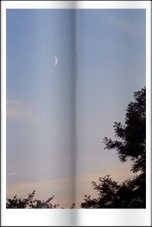
An inspiring sight, at dawn, or the evening twilight is to see some last -or first- stars shining, alone, or in some closeness with another one, in the first -or last- gleamings of the Sun. Mostly that may be about two kinds of things. First it may be one, or two planets. Second, it may be a planet (with possibly a star). Or, more rarely, it may be two stars, bright and close together
What about planets seen in the the morning or evening twilight? The Earth, with the 8 other planets of the solar system, is orbiting around our star, the Sun. The nine planets of the solar system, in this order from the Sun are: Mercury, Venus, the Earth, Mars, Jupiter, Saturn, Uranus, Neptune, and Pluto. 5 of those only, are visible naked-eye from the Earth: Mercury, Venus, Mars, Jupiter and Saturn! The visibility, in our skies, of these planets depends upon two factors. The relative position of the planets on their orbits, relatively to where Earth is on its own, one. And whether the planet is located between the Earth and the Sun, or beyond the Earth. A planet you'll see at dawn or twilight, will either be one of the 'inner' planets, Mercury and Venus, which are located between us and the Sun, or an 'outer' one, like Mars, or Jupiter, which are located in space beyond us. The fact that you'll see either Mercury of Venus in the sky at dawn, East or in the twilight, West, is due to that it's the only location and moment in the sky where you can seen those both inner planets. Due to their proximity to the Sun relative to us, they never seem to wander far from the Sun, hence always visible like a 'morning' or an 'evening star'! Should you see a bright star, few after sunset, West, it's surely Venus (and the same in the morning). Should the star be less bright, seen later after sunset and low, then it's surely Mercury (Mercury, in the northern hemisphere, is much rarely seen however, due to the elevated latitudes there). In the case of a bright star, further, the said star may just be an outer planet. Mars, Jupiter or Saturn, that is. Due to that they are beyond us in the sky, those planets may be seen in the evening, or the morning, few after sunset or before sunrise, due to anothe reason than for Mercury or Venus. It's just then a question of perspective, with their relative position to the Earth being such that they are seen beyond the Sun someway. For an astronomer, such a position is near when an outer planet is reaching just over the Sun relative to the Sun, a position called the 'conjunction'. The planet then is unobservable. When seen in the twilight or at dawn, Mars, Jupiter, or Saturn, are progressively moving to that position! Well. And what if two bright objects East, or West? Well, it's either a closing of two planets, or a closing between one planet and one star. Closenesses between two planets -and in more rare cases more- are just due to the overall and aleatory motions in the solar system. At intervals, such or such planets may be seen together, in perspective, in the same patch of sky. That's providing for fine shows -and pics! And the same, with a planet -and sometimes more- and a star. That time, it's about chance too, or, better to the motion of the planets on their orbits and how that places them, in perspective, on the starry background. That particularly true for planets like Jupiter and Saturn, with them progressively moving on the background of the stars, each year. Jupiter, thus, takes about 12 years to make a whole journey through the stars! At moments of this journey, it will necessarily be seen near such or such relatively bright, or bright star!
As far as the stars are concerned, they just appear along with that the sky is darkening. The brightest stars are seen first in twilight -or last, at dawn- as the fainter the stars, the later they appear -or the later they fade! Each night, you might see about 5,000 stars in the whole sky! Stars are classified by astronomers function of their apparent luminosity according to a scale called the scale of magnitudes. The magnitude scale originates back to the Greeks. Stars were then divided into six classes. The brightest stars are in the first class, faintest in the 6th. Each class represents a star brightness 2.512 times fainter than the previous: a star of magnitude 3 is 2.5 times less bright than a star of magnitude 2, and 2.5 times brighter than a star of magnitude 4. Stars brighter than class 1 are termed negative (e.g. Sirius, the brightest star in Northern hemisphere is magnitude - 1.5). It's relatively rarer to see two bright stars close together. Mostly, if you see two bright object near to one another in the twilight or at dawn, it probably will be a planet and a bright star. Should you keeping looking at the pair when the sky keeps darkening, you'll definitely see what's the main difference, in the night sky, between a planet and a star! A star is twinkling, as a planet is shining in a steadily manner. That's obvious, even to casual observers! For being ascertained of what you see in the twilight or dawn, the best way is to refer to an ephemeridis site, giving you either the remarkable position of planets and/of remarkable stars at dawn or in twilight, or the main hits to it!
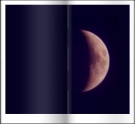
Another object you're most likely to spot in twilight, or at dawn, is, obviously, the Moon. The Moon, like everyone knows, is the Earth's moon. The Moon is the celestial objects which is the closest to us, at about 239,000 miles (380,000 kilometers) from us. The most striking feature of the Moon is that, along about one month, it's displaying 'phases'. The Moon, thus, is seen under the form of a crescent, or it's the Full Moon, or a quarter Moon. What's that? This is simply due to that the Moon is orbiting around the Earth and to its relative position to us and the Sun! The Moon, on the other hand, due to its revolution period around the Earth equaling its rotation period on itself, always had the same side of it facing Earth. The far side of the Moon remained unknown until the space age!
In the northern hemisphere, just after the new moon, the first crescent Moon appears West and day after day, it gets distant from the Sun at the same time is increases in size. At first quarter, you will note that Moon appears due South when Sun sets. The quarter Moon become waxing gibbous and it appears more East each day. When Moon reaches full, it's rising East just when Sun is setting West. Moon then sets in turn about 12 hours later that is by next morning. Waning gibbous Moon rises later each day until it reaches last quarter. Moon then rises at midnight and sets about midday. The last crescent completes the cycle as it rises less and less early before Sun. Generally, each night, the Moon is moving by about 12.5° relative to the background stars where it was located the previous day. After Moon is full, you often can see it until well in the morning sky, each day. Or, before a Full Moon, you can see it in the eastern part of the sky long before the Sun sets
 | click to Moon's phases |
A famed, remarkable faint light, further, is displayed during that Moon is a crescent or a quarter. This is called the 'ashen light', the 'ashen glow', or the 'Earthshine", and it is a fine show. Moon's part which is still in night is lit by "earthshine". For an observer located on the Moon it would be night and Earth would be shortly after "Full Earth", ornating their skies. The ashen glow is seen too at last quarter Moon when last crescent is rising on eastern horizon. A popular expression is terming the ashen glow "the old Moon in the New Moon's arms"
Binoculars or a spotting scope may be used to the Moon! With even small magnifications you'll be able to already better spot the main Moon relief features. You'll see how the Moon's terrain is parting between bright, old, mountaneous regions, flat, dark, large plains, and as it's variously spotted with varied craters! Another observation will be too that the relief features are more accurately seen along what is called the 'terminator', that line which defines in what phase the Moon currently is (it's where the surface of the Moon divides into the part which is lit by the Sun, and the part which is not). Moon was reached by man during the 1960's and the beginning of the 1970's by the Apollo missions as the USA are aiming to bring man back to Moon about 2020 now. To the naked-eye, the Moon's main features -the light, ancient and mountaneous terrains, and the dark plains -or 'mare'- are seen like this alternance of white and darker regions. The first Apollo landing took place in one of the dark mare one sees in the upper right part of the Moon
The four seasons, at Earth -winter, spring, summer, and fall- are some defining moments, impacting the length of days, nights... and the weather! The four seasons are just, indeed, four astronomical moments. That's much easy to understand. Let's first consider that the Earth's axis (this imaginary line joining both the South and North poles) is tilted. That's the result of a most antique time, just linked to the formation of the Earth and the interaction with the Moon. The tilt, accurately, is of 23.5°. That tilt just is unaffected by the revolution of the Earth on its orbit! And that is of consequence. At some point of the orbit of the Earth, the Earth's axis is tilted towards the Sun, as at another point, it's tilted away, and at some moments, it's neutral -neither tilted towards nor away!
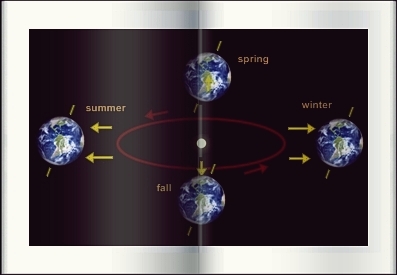
Four pecular moments on the orbit define precisely the seasons (just like illustrated above)
As far as Earth's hemispheres are concerned, seasons are reverted of course. When it's winter North, is summer South e.g. This is due to that when the northern hemisphere is at a given tilt relative to the Sun, the southern hemisphere is correlatively at the opposite tilt. Strictly speaking equatorial regions do not have any delineated seasons. Temperatures, vegetation, and the length of days are remaining identical all year long! Some last, advanced considerations: as the Earth's orbit is not exactly a circle but an ellipse, Earth, at a moment of the year, is nearest to the Sun and at its farthest, at another moment. The nearest point is termed the 'perihelion', the farthest is the "aphelion" (from the Greek 'peri' ('near'), 'a' (privative, 'far'), and 'helios' (the Sun)). The perihelion takes place each year about January, 2nd, as the aphelion about July, 4th. As such an inconsistency is of few importance in the northern hemisphere, it is much more important in the southern hemisphere. It's when the southern part of the Earth is tilted towards the Sun that Earth, at the same time, is nearest to the Sun hence southern summers are warmer than the northern ones! On the other hand, the aphelion does not yield colder southern winters however. This might be due to the oceans, with their much more important surface in the southern hemisphere, thus having a tempering effect!
The twilight is the period of time following sunset or preceding sunrise (in the latter case, one speaks of dawn, in the current language). Some light is still/or already provided by sun's light, which is reaching the upper atmosphere, as seen from the observer's point of view. Those moments are providing for fine sights, West or East, are, while the sky is getting progressively darker, allowing to see the first stars or planets, light is still well present, keeping ornating the part of the sky turned towards where the Sun has set, or where it's going to rise. Some magic moments!
Some more precisions now, with, officially, three definitions of what the twilight may be (be it, according to the official terms, the 'morning', or 'evening twilight':
The illustration below is showing how the sky is looking like, in the evening, or the morning, according to the four definitions above

Some more precisions are of interest, like that sunrise and sunset, moonrise and moonset are officially specified like the moments when the disk's upper edge of the Sun or of the Moon is on the horizon (Moon in crescent is considered a disk, the upper edge might be dark). The 'transit' -or 'culmination'- of a celestial body in the sky of the observer, is the moment when the Sun's or the Moon's disk center crosses the observer's meridian (your due South, that is, whatever the elevation of the object may be)
With all those things you learn, maybe you might want to learn some more on how all that sky is working! That's relatively simple. The first point is to consider that the Earth is a celestial body, and a member of the solar system. As a celestial body, the Earth is orbiting around the Sun, determining various events and varied views, in perspective, of the sky which surrounds us, as, as a member of the solar system, a planet linked to its Sun, the Earth is part of much vaster ensembles, far beyond!
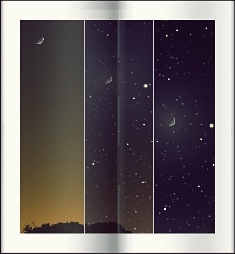
Earth, on its orbit, as far as the nearest objects to us in the sky are concerned, allows to see those under varied angles and moments. The height of the Sun according to the seasons, the way the planets are moving against the background sky, the day and the night, all that is determined by the Earth's orbit and motions. Earth, first, is revolving on itself in 24 hours. That's -whatever its position on the orbit- is defining the alternance of the days and nights. As it orbits the Sun during one year, this, like we saw, is determining the seasons (the day's and night's length varies according to the seasons too). Earth is one of 9 planets orbiting around the Sun. As most of the planets are orbiting -Pluto is the exception- in the same plane, around the Sun, this means that the Sun and the planets, mostly, are seen, against the starry background, moving along a same path. This is called the 'ecliptic'. On sky charts or planetariums, you might spot that line spanning over the sky. It's along that line that you'll have to look for the planets. The daily revolution of the Earth about itself is what is defining that the objects, or the Moon, you'll catch in twilight or at dawn, after a certain amount of time, will shift West and lower, or will rise in the sky!
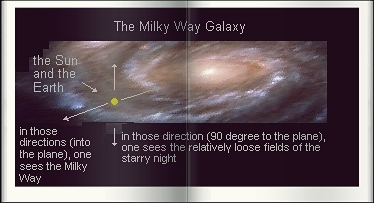
The Earth, on the other hand, with the Sun and the solar system is not suspended in the void of space! At the contrary, like everybody knows, it's part of a vast ensemble of hundreds of billions of stars, which is called the Milky Way Galaxy. The Milky Way Galaxy is one of those famed pinwheel, spiral galaxies like the ones popularized by the media. All the stars one can seen in the night sky are just all those billions of stars. As our Galaxy is of much vast dimensions -100,000 light-years, 100,000 times 5,880 billion miles (9,463 billion km)!- we see mostly those which are the brightest, or the nearest to us, and, mostly, we see those relatively loose fields of stars of our nights when we look away from the plane of the Galaxy. When looking in the direction of the plane, the stars are so densely there, and so far away, that we can't see them individually anymore and that we see them under the form of the Milky Way! Simply! Beyond the Milky Way Galaxy, are just the vast voids of space, populated here and there by some other galaxies, as, eventually, should one be able to get distant enough from all that, we would have a comprehensive view of the Universe, seeing how it's all about filaments of gas and galaxies, in a diameter of 28 billion light-years...
->Feeling interested? Want to know more? see all our tutorials and sections at 'Amateur Astronomy'!
Website Manager: G. Guichard, site 'Amateur Astronomy,' http://stars5.6te.net. Page Editor: G. Guichard. last edited: 12/28/2010. contact us at ggwebsites@outlook.com